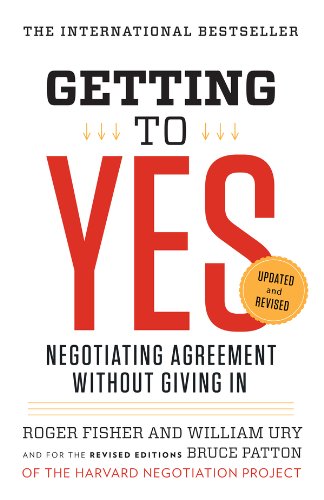

This article is an excerpt from the Shortform summary of "Getting to Yes" by Roger Fisher and William Ury. Shortform has the world's best summaries of books you should be reading.
Like this article? Sign up for a free trial here .
When entering a negotiation, you often think only of your own interests. How could it benefit you to negotiate a deal that results in mutual gains? And is it possible to achieve mutual gains without compromising what you want?
Believe it or not, finding mutual gains is in your best interest as well as the other party’s best interest. We’ll look at why seeking mutual gains is important in negotiations and how to find mutual gains.
Why Mutual Gains?
A common challenge in negotiations arises when there doesn’t seem to be a way to split the pie that serves both sides. The choice seems to be having a winner and a loser, and neither side wants to lose. But the dilemma opens up the opportunity for creative options that expand the pie before dividing it. A creative solution can break an impasse and result in a better agreement and mutual gains.
But standard negotiation methods don’t often produce many opportunities for mutual gain. The people on both sides don’t see a need for brainstorming multiple solutions. They believe they have the right answer, that their position is reasonable, and that it should be accepted. A suggestion to split the difference is as creative as they get. The resulting agreement doesn’t serve either party as well as it should and doesn’t result in mutual gains.
Here are some additional obstacles to generating multiple options and finding mutual gains during negotiations:
- Premature criticism: Your inner critic hinders your imagination. You also fear the other side’s reaction to a proposal — either dismissing it or taking it as a commitment. You fear jeopardizing your bargaining position.
- Searching for the one best answer: People see their job as narrowing the options, not expanding them, which would make things more complicated. They’re afraid discussion will delay and confuse the process; they’re looking for the single best offer.
- Assuming the size of the pie is fixed: People see the situation as either/or, a fixed-sum game ($100 for you means $100 less for me. I can only satisfy you at my expense.) They believe that if one side wins, the other side must lose.
- Reluctance to seek ways to satisfy the other side: Each side is concerned only with its immediate interests. Neither can detach and think of ways to satisfy the other side or the interests of both. They also may hesitate to legitimize the other side’s views. This leads to self-serving proposals.
How to Increase the Options for Mutual Gains
To invent creative options, separate the act of inventing from judging, broaden the options beyond a single answer, explicitly search for mutual gains, and make decisions easy.
Separate Inventing from Deciding
Since judgment gets in the way of imagination, set up a brainstorming session for your side to come up with creative ideas that can be winnowed and refined later. At this point, you can focus on your own goals rather than solutions that offer mutual gains.
- To get started with brainstorming: Establish your purpose: what do you want to leave the meeting with? Choose a small group of participants (five to eight). Choose a time and place conducive to creativity. Choose a facilitator to keep things on track.
- During brainstorming: Sit facing a whiteboard. Ban criticism and clarify other ground rules. Brainstorm — come up with a long list of ideas, approaching the topic from every angle. List the ideas on the whiteboard.
- After brainstorming: Identify the most promising ideas. Relax the no-criticism rule. Think of ways to improve on the best ideas and implement them. Set up a time to finalize the list, deciding which ideas to put on the table for negotiation.
Brainstorming with people from the other side can also be valuable. Benefits include producing ideas that encompass all interests and offer mutual gains, creating a problem-solving climate, and increasing each side’s understanding of the other’s concerns. It’s important, however, to distinguish brainstorming from a negotiation session: Discuss options rather than take positions; ask questions rather than making assertions.
Broaden Your Options
The next step toward finding mutual gains is broadening your options. When you create a large number and variety of options, you develop room in which to negotiate. Creating options involves four steps, including both general and specific thinking:
- Describe the problem. What’s wrong? What are the symptoms of the problem? What are the current facts compared to an ideal situation?
- Analyze the problem. Name/diagnose the problem, categorize symptoms, suggest possible causes, and note barriers to fixing the problem.
- Consider various approaches. What are some possible strategies and prescriptions?
- Come up with ideas for action. What could be done? What specific steps could be taken to deal with the problem?
You can start with general thinking and move to specifics or go backward. When you have a promising idea, go back and try to identify the general (theoretical) approach behind it. This could generate more ideas along the same line.
Here are some additional ideas for generating options:
- Think like an expert. Imagine how experts in different fields would view your problem. For example, consider a child custody issue from the perspective of a teacher, minister, lawyer, doctor, and psychiatrist. What questions would they ask; what would their priorities be?
- Consider a range of agreements, from looser to more binding. In case you can’t reach an optimal agreement, have backup plans. Agree on a procedure for moving forward if you can’t agree on substance (for instance, hiring a mediator or arbitrator). Clarify where you agree and disagree. Consider a tentative, “in principle,” non-binding, or contingent agreement.
- Consider changing the scope. Break down the agreement into smaller parts, possibly limited to particular matters, involving few parties, or remaining in effect for a limited period. On the other hand, consider how expanding the scope could make the agreement better or more attractive.
Look for Mutual Gain
Now it’s time to get over the assumption that the pie is fixed, that “if you get less, I get more.” Usually, this isn’t the case. There’s almost always a way both sides can gain through a creative solution that addresses shared interests and results in mutual gains.
Sometimes shared interests aren’t obvious, but making the effort to find them is in your interest. The alternative, in which the other side gets nothing, is also bad for you. For example, if your customer goes away feeling cheated, you’ll lose both the customer and your reputation. Also, you want the other side to be satisfied enough to comply with the agreement.
Additional points about mutual gain to keep in mind are:
- Shared interests exist in every negotiation, though you can’t always see them. If they’re not immediately obvious, ask the other side about their goals and the reasons behind the goals.
- Shared interests are opportunities, but not slam dunks — you have to make something of them. Take a shared interest and shape it into a shared goal that’s concrete and future-oriented.
- Emphasizing shared interests can make negotiations smoother and friendlier. People de-emphasize differences when pursuing mutual interests.
- You can reach an agreement even if each side wants different things, as long as those things are complementary, or low-cost to one side and high-benefit to the other. Recall the Jack Sprat nursery rhyme, in which Jack’s and his wife’s dietary preferences were complementary (he couldn’t eat fat; she couldn’t eat lean). There are many common areas of complementary interests. For example, one side may care more about reputation while the other cares more about results. One side may be focused on immediate concerns while the other is taking the long view. Other complementary interests include economic versus political considerations and internal versus external concerns.
Make It Easy for the Other Side to Decide in Your Favor
You succeed in negotiations when the other side agrees to give you what you want. You should make this decision as easy for them as possible. That means taking care of their interests and striving toward solutions that offer mutual gains. To broaden your thinking beyond your immediate interests, put yourself in their shoes:
- Pick a specific person. The other side may include multiple people and entities. Ask yourself who you’re trying to influence and zero in on a person. Consider the problem and possible solutions from that person’s perspective. You can’t negotiate with an abstract entity such as “the university.”
- Draft several potential agreements attractive to them. Make the terms attractive to them, but beneficial to both sides. Make the agreements easy to implement. Make them seem legitimate (the right thing to do) in terms of being legal, fair, and honorable. Base them on a comforting precedent so they’re consistent with their past views and actions.
- Clarify the consequences, good and bad. Consider the consequences of agreeing from their perspective. What results would they desire and what would they fear? Focus on making the positive results even more attractive: how could they defend accepting it to their constituents; what are some specific things they might like. Finally, draft a proposal they could say “yes” to (one that’s satisfactory, realistic, and can be implemented).
———End of Preview———

Like what you just read? Read the rest of the world's best summary of "Getting to Yes" at Shortform . Learn the book's critical concepts in 20 minutes or less .
Here's what you'll find in our full Getting to yes summary :
- Why the standard way of negotiating is completely wrong
- How to find outcomes that are wins for both sides
- How to protect yourself against aggressive negotiators






